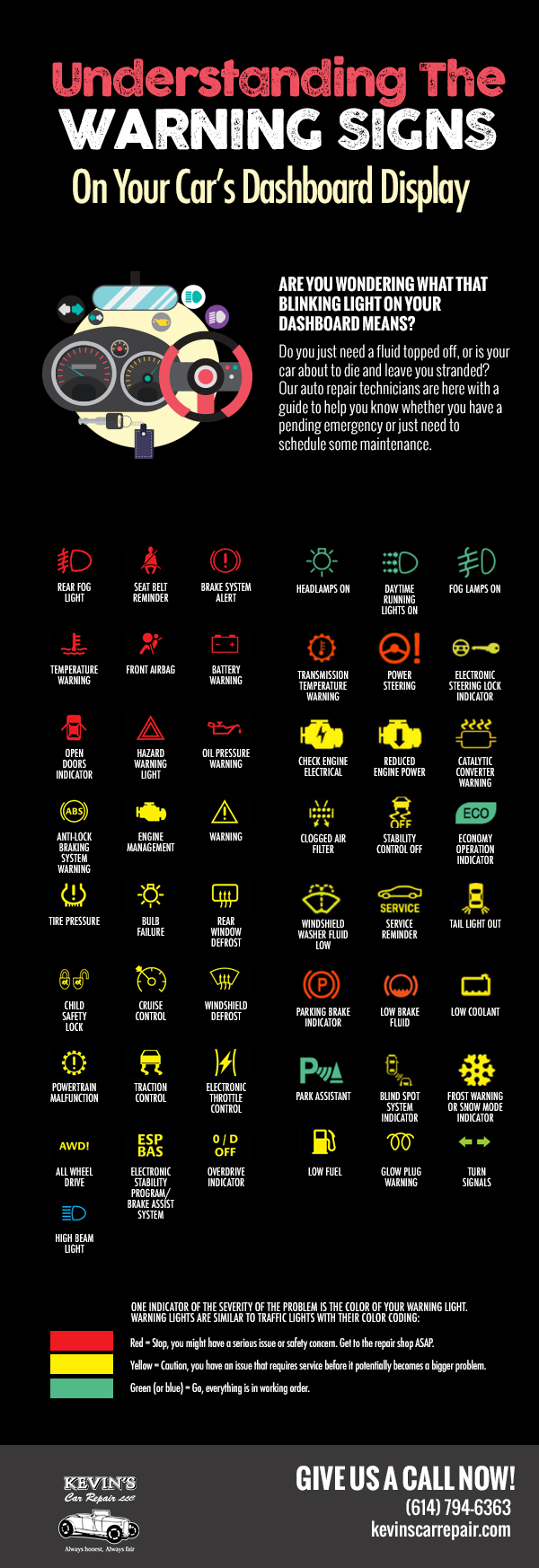Examining Your Auto'S Caution Indicators: What They Actually Share
Examining Your Auto'S Caution Indicators: What They Actually Share
Blog Article
Write-Up By-Hartley Torres
When you're behind the wheel, those radiant caution lights on your control panel can be a bit complicated. Do you understand what they're trying to tell you about your vehicle's health and wellness? Comprehending related webpage of these lights is vital for your security and the longevity of your car. So, the next time one of those lights pops up, would not you intend to analyze its message properly and take the needed actions to resolve it?
Common Warning Lights and Interpretations
Identify usual caution lights in your automobile and comprehend their significances to make sure secure driving.
One of the most regular warning lights consist of the check engine light, which indicates issues with the engine or discharges system. If this light begins, it's vital to have your vehicle examined without delay.
The oil pressure alerting light suggests reduced oil stress, requiring prompt interest to avoid engine damage.
A flashing battery light could recommend a defective charging system, possibly leaving you stranded otherwise resolved.
The tire pressure monitoring system (TPMS) light informs you to low tire stress, impacting vehicle stability and gas efficiency. Overlooking this might bring about harmful driving conditions.
The abdominal light shows an issue with the anti-lock braking system, jeopardizing your capacity to stop swiftly in emergencies.
Lastly, the coolant temperature level alerting light warns of engine getting too hot, which can lead to serious damages otherwise solved swiftly.
Comprehending these usual warning lights will assist you deal with concerns promptly and keep risk-free driving conditions.
Importance of Prompt Attention
Understanding the typical warning lights in your car is just the primary step; the value of promptly addressing these warnings can not be emphasized enough to ensure your safety when traveling.
When view it now brightens on your control panel, it's your automobile's means of communicating a possible issue that needs focus. Neglecting these warnings can cause much more extreme issues in the future, jeopardizing your safety and potentially costing you much more out of commission.
Prompt interest to warning lights can avoid malfunctions and accidents. For example, a flashing check engine light can suggest a misfire that, if left ignored, could create damages to the catalytic converter. Resolving this without delay can save you from a pricey fixing.
Likewise, a brake system cautioning light may indicate reduced brake fluid or worn brake pads, essential components for your safety when driving.
Do It Yourself Troubleshooting Tips
If you notice a caution light on your control panel, there are a few do it yourself fixing suggestions you can try prior to looking for professional aid.
https://ecu-tuning28495.livebloggs.com/36521544/individual-journey-rejuvenating-my-old-lorry-through-a-weekend-explaining-task is to consult your car's guidebook to understand what the particular caution light suggests. Often the concern can be as straightforward as a loose gas cap causing the check engine light. Tightening up the gas cap might deal with the problem.
Another common problem is a reduced battery, which can trigger numerous alerting lights. Inspecting the battery links for corrosion and guaranteeing they're protected may repair the problem.
If a caution light continues, you can attempt resetting it by disconnecting the automobile's battery for a couple of mins and after that reconnecting it. Furthermore, inspecting your lorry's fluid levels, such as oil, coolant, and brake liquid, can aid fix advising lights connected to these systems.
Verdict
Finally, recognizing your car's warning lights is important for maintaining your automobile running efficiently and safely. By quickly attending to these informs and recognizing what they mean, you can stay clear of costly fixings and possible failures.
Remember to consult your cars and truck's manual for specific information on each alerting light and take action appropriately to ensure a trouble-free driving experience.
Remain educated, remain risk-free on the road!
